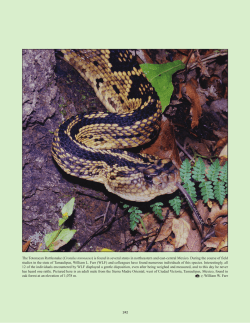
( Ictalurus punctatus) from three dams in Nuevo Leon - Redalyc
Red de Revistas Científicas de América Latina, el Caribe, España y Portugal Sistema de Información Científica Galaviz-Silva, Lucio; Molina-Garza, Zinnia Judith; Escobar González, Baldemar; Iruegas-Buentello, Francisco Javier Metazoan parasites of the channel catfish ( Ictalurus punctatus) from three dams in Nuevo Leon, Mexico Hidrobiológica, vol. 23, núm. 3, 2013, pp. 394-398 Universidad Autónoma Metropolitana Unidad Iztapalapa Distrito Federal, México Available in: http://www.redalyc.org/articulo.oa?id=57832087012 Hidrobiológica, ISSN (Printed Version): 0188-8897 [email protected] Universidad Autónoma Metropolitana Unidad Iztapalapa México How to cite Complete issue More information about this article Journal's homepage www.redalyc.org Non-Profit Academic Project, developed under the Open Acces Initiative Hidrobiológica Galaviz-Silva 2013, 23 (3): 3L.94-398 et al. 394 Metazoan parasites of the channel catfish (Ictalurus punctatus ) from three dams in Nuevo Leon, Mexico Metazoarios parásitos del bagre de canal (Ictalurus punctatus ) de tres presas en Nuevo León, México Lucio Galaviz-Silva, Zinnia Judith Molina-Garza, Baldemar Escobar-González and Francisco Javier Iruegas-Buentello Universidad Autónoma de Nuevo León, Facultad de Ciencias Biológicas, Unidad B. Ave. Universidad SN, Cd. Universitaria, San Nicolás de los Garza, Nuevo León, 66451, México e-mail: [email protected] Galaviz-Silva L., Z. J. Molina-Garza, B. Escobar-González and F. J. Iruegas-Buentello. 2013. Metazoan parasites of the channel catfish (Ictalurus punctatus) from three dams in Nuevo Leon, Mexico. Hidrobiológica 23 (3): 394-398. ABSTRACT The freshwater channel catfish (Ictalurus punctatus, Rafinesque, 1818) is one of the world-wide highlight species in aquaculture. Despite the growing presence of this fish in the farming industry, its parasitic fauna is rarely studied in Mexico. This survey was designed to provide insight into the occurrence and abundance of parasitic fauna of I. punctatus and to contribute to the national inventory of parasites of this fish. This study was performed at the following three dams in the state of Nuevo Leon, Mexico: Cerro Prieto, Rodrigo Gomez, and El Cuchillo-Solidaridad. Seven helminths and 1 copepod species were recorded from the 24 I. punctatus collected. This record consists of a total of 4,687 parasites, of which 108 were endoparasites and 4,579 ectoparasites. Our findings demonstrate a great diversity of helminth parasites, including Ligictaluridus floridanus, and Corallobothrium fimbriatum, and new locality records for Megalogonia ictaluri, Centrocestus formosanus, Diplostomum (Austrodiplostomum) compactum, Spiroxys sp., the copepod Ergasilus cerastes, and a new host and distribution record was reported for Spinitectus tabascoensis, originally described from I. furcatus from Tabasco, southern Mexico. Key words: Copepod, helminth parasites, Ictalurus. RESUMEN El bagre de canal (Ictalurus punctatus) es una de las especies que destacan a nivel mundial en la acuacultura. Aunque la presencia de esta especie es cada vez mayor en la industria pesquera, su fauna parasitaria en México ha recibido escasa atención. Esta investigación tiene como objetivos obtener información sobre la prevalencia y abundancia de la fauna parasitaria de I. punctatus y contribuir al inventario nacional de los parásitos de este hospedero. El estudio se realizó en tres presas del estado de Nuevo León: Cerro Prieto, Rodrigo Gómez y El Cuchillo-Solidaridad. Fueron registradas siete especies de helmintos y una especie de copépodo de 24 I. punctactus. Los resultados obtenidos consisten en un total de 4,687 parásitos, de los cuales 108 fueron endoparásitos y 4,579 ectoparásitos. Los resultados demuestran una gran diversidad de helmintos parásitos, incluyendo a Ligictaluridus floridanus, Corallobothrium fimbriatum y un nuevo registro de localidad para Megalogonia ictaluri, Centrocestus formosanus, Diplostomum (Austrodiplostomum) compactum, Spiroxys sp. y el copepodo Ergasilus cerastes, así como un nuevo registro de hospedero y localidad para Spinitectus tabascoensis, originalmente descrito en Ictalurus furcatus en Tabasco al sur de México. Palabras clave: Copépodos, helmintos parásitos, Ictalurus. Hidrobiológica 395 Parasites of channel catfish (Ictalurus punctatus) INTRODUCTION Channel catfish (Ictalurus punctatus Rafinesque, 1818) are native to the flowing waters in the temperate environments of North America, including southern Canada and northern Mexico (FAO, 2012). In northern Mexico, channel catfish are found in the Nuevo Leon and Tamaulipas states. Freshwater channel catfish is one of the most common species cultured in Mexican aquaculture. Its production has increased, and it accounts for 60.6% of the national production from fisheries. The channel catfish was translocate in 1976 to the most central and southernmost states of the country (CONAPESCA, 2010). Despite its growing presence in the farming industry, information concerning helminth parasites associated with this species in Mexico is scarce (Galaviz-Silva et al., 1990; Pérez-Ponce de León & Choudhury, 2002; Salgado-Maldonado, 2006; Rosas-Valdez & Pérez-Ponce de León, 2008). The present work aimed to characterize the prevalence and abundance of the parasitic fauna of wild channel catfish collected at three different reservoirs in Nuevo Leon, Mexico. MATERIAL AND METHODS The state of Nuevo Leon is located in northeast Mexico. It has three principal dams that are used primarily for water capture and storage, commercial sport fishing and ecotourism. Rodrigo Gomez (known as “La Boca”, 25°24’ N, 99°14’ W) and El CuchilloSolidaridad (25°38’ N, 99°14’ W) are located in the municipalities of Santiago and China, respectively. Both dams were constructed on the main stream of the San Juan River in the Grand River hydrological region. The Cerro Prieto reservoir (Linares municipality) has two tributaries, the Hualahuises and Pablillo rivers, which serve as the main sources of inflow into the reservoir, and the reservoir is located in the San Fernando-Soto La Marina hydrological region (Fig. 1). The climate of the reservoirs is arid to semi-arid, and it contains vegetation and wildlife that include Taumalipan scrub and chaparral desert ecosystems (INEGI, 2012). Freshwater channel catfish (9 from Cerro Prieto, 8 from Ro- drigo Gomez, and 7 from El Cuchillo-Solidaridad) were obtained from local fishermen from November 2009 to February 2010 and transported on ice (Guidelli et al., 2011; Kritsky et al., 2011). At the laboratory, the external surfaces (skin and fins) were examined for ectoparasites. Then, the gills were excised, and the soft tissue and mucosa were scraped off with forceps to detect copepods and monogeneans using a stereo dissecting microscope. The internal organs, including the heart, liver, intestines, and stomach, were separated and examined for metazoan parasites under a stereo dissecting microscope and compound microscope according to standard parasitological techniques (Vidal-Martínez et al., 2002). Live parasites were killed by immersion in hot fixatives (4% formalin). Unflattened monogeneans were mounted unstained in Gray and Wess medium to study the sclerotized structures; other flattened specimens were stained with Gomori’s trichrome and Vol. 23 No. 3 • 2013 Figure 1. Map of Nuevo Leon state, showing sampling sites. A) Rodrigo Gómez. B) El Cuchillo-Solidaridad. C) Cerro Prieto dams. mounted in synthetic resin (Entellan, Merk, Germany) to study the internal anatomy. Digeneans and cestodes were fixed by immersion into AFA (formalin-ethanol-acetic acid) for 24 h in either unflattened or flattened conditions. Subsequently, platyhelminths were stained in Van Cleave or Delafield´s hematoxilyn, dehydrated using a graded alcohol series, cleared in methyl salicylate, and mounted whole on slides. Nematodes were stored in 70% ethanol and examined after being cleared in lactophenol. Copepods were fixed in a 5% formalin solution, preserved in 70% ethanol and diaphanized with lactophenol. The copepods were identified according Roberts (1969), Amado and Rocha (2001), and Boxshall et al. (2002). Voucher specimens of each species have been deposited in the Colección de Parásitos de la Universidad Autónoma de Nuevo León (CP:UANL). Abundance was defined as the number of conspecific parasites living in (or on) any host, and prevalence was expressed as the percentage of channel catfish infected relative to the number examined in a sample, as defined in Bush et al. (1997). RESULTS In total, 8 species of parasites were obtained from channel catfish (3 larval and 5 adults), including 1 monogenean, 3 digeneans, 1 cestode, 2 nematodes, and 1 copepod. This record consists of a 396 Galaviz-Silva L. et al. total of 4,687 parasites, of which 108 were endoparasites, including Megalogonia ictaluri (Surber, 1928); Centrocestus formosanus (Nishigori, 1924); Diplostomum (Austrodiplostomum) compactum Lutz, 1928; Corallobothrium fimbriatum Essex, 1927; Spinitectus tabascoensis Essex, 1927; and Spiroxys sp. In this report, 4,579 ectoparasites were recorded, including Ligictaluridus floridanus Mueller, 1936; and the copepod Ergasilus cerastes Roberts, 1969 (Table 1). DISCUSION There are very few studies referring to Ictalurus punctatus parasites from Mexico, and this is the first study on I. punctatus parasite communities in Rodrigo Gómez, El Cuchillo-Solidaridad, and Cerro Prieto reservoirs. Although the present collection of channel catfish was small (only 7-9 specimens examined by locality), we observed that the monogenean Ligictaluridus floridanus was found in all three reservoirs and was the most prevalent (69%100% for locality) and abundant (51.3-334.3, Table 1). L. floridanus was previously reported on I. punctatus and Cyprinus carpio Linnaeus from three fish farms: Vicente Guerrero (Abasolo, Tamaulipas), Salinillas, (Anahuac, Nuevo Leon), and La Rosa (General Cepeda, Coahuila). However, the previously reported prevalence was lower than that reported in this study, which ranged from 14.9% to 38.3% (Galaviz-Silva et al., 1990). L. floridanus has also been reported on Ictalurus furcatus (Valenciennes) caught in Presa La Angostura, Chiapas (Pineda-López, 1985a). The prevalence of Diplostomid metacercarie Diplostomum (A.) compactum in the three reservoirs was documented (14%- 89%). Previous reports have recorded this helminth on Rhamdia guatemalensis Günther from Oaxaca (Salgado-Maldonado, 2006); I. furcatus caught in Chiapas and Tabasco (Pineda-López, 1985b) and I. punctatus from Sonora (Hernández-Martínez, 1992). This is the first official report of this parasite in Nuevo Leon, Mexico. M. ictaluri and Spiroxys sp. (larvae) have been reported on I. punctatus in Veracruz and Tamaulipas. Centrocestus formosanus was reported on I. punctatus in Hidalgo (Rosas-Valdez & Pérez Ponce de León, 2008), and Salgado-Maldonado et al. (1995, 2005) reported C. formosanus on several freshwater fish species from Oaxaca and Tabasco. However, this paper is the first to report the presence of Megalogonia ictaluri, Spiroxys sp., and C. formosanus (larvae) on I. punctatus in Nuevo Leon. In this work, the cestode Corallobothrium fimbriatum and the nematode Spinitectus tabascoensis, which have been widely recorded in Mexico (Moravec et al., 2009, 2010; Rosas-Valdez & Pérez Ponce de León, 2008; Salgado-Maldonado, 2006; Vidal-Martinez et al., 2002), were also found, but with a low to moderate prevalence (Table 1). Spinitectus tabascoensis was compared with the key species of Spinitectus, which parasitizes freshwater fish in Mexico (Moravec et al., 2010; Salgado-Maldonado, 2006), it was originally described from I. furcatus from Usumacinta River, Tabasco, southern Mexico (Moravec et al., 2002), and in the present report, it is considered as new host and distribution record for I. punctatus from Nuevo Leon, located at northeast of Mexico. Also, a new locality record was created for the Ergasilus cerastes observed in this study because only E. versicolor Wilson, 1911 and E. davidi Suárez-Morales & Santana-Piñeros, 2008 have been reported as part of the parasitic fauna of fish. The former was reported as Table 1. Parasite list of Ictalurus punctatus from three reservoirs in Nuevo Leon, Mexico. Parasite species Structure were the parasite was found CP:UANL Cerro Prieto Rodrigo Gómez El Cuchillo-Solidaridad 1n = 9 2n = 8 3n = 7 Prevalence (Abundance) Megalogonia ictaluri (Surber, 1928) Intestine 2016 14 (0.6) Centrocestus formosanus (Nishigori, 1924) Gills 2022 14 (0.7) Diplostomum (Austrodiplostomum) compactum Lutz, 1928 Eyes 2011, 2012 2013 89 (5.1) Ligictaluridus floridanus Mueller, 1936 Gills 2019, 2020 75 (3.6) 14 (0.6) 2021 69 (51.3) 75 (217.8) 100 (334.3) Corallobothrium fimbriatum Essex, 1927 Intestine 2017, 2018 11 (0.4) Spinitectus tabascoensis Essex, 1927 Intestine 2023 11 (0.6) Spiroxys sp. Mesentery Ergasilus cerastes Roberts, 1969 Gills 29 (0.3) 2024 2014, 2016 29 (1.3) 11 (1.2) 50 (3.0) n = number of fish examined. Prevalence is expressed in percent. CP:UANL- Colección de Parásitos de la Universidad Autónoma de Nuevo León. 1November 2009, 2December 2009, and 3February 2010. Hidrobiológica Parasites of channel catfish (Ictalurus punctatus) an ectoparasite of Mugil cephalus Linnaeus, which was collected in the Colorado River in Baja California (Valles-Ríos et al., 2000), and of I. punctatus caught in Anahuac, Nuevo Leon, Mexico (Galaviz-Silva et al., 1990). E. davidi has also been reported on the gills of yellow snapper Lutjanus argentiventris (Peters) and yellowfin snook Centropomus robalito Jordan and Gilbert, found in the Pacific coastal system of Chiapas, Mexico (Suárez-Morales & Santana-Piñeros, 2008). In the present study, the occurrence of Ergasilus cerastes was documented for the first time in Nuevo Leon, Mexico. The present study provides new data on species abundance and the prevalence of parasitic fauna on Ictalurus punctatus from Mexico, and it complements the checklist of previously reported parasites (Pérez-Ponce de León & Choudhury, 2002; Salgado-Maldonado, 2006; Rosas-Valdéz & Pérez-Ponce de León, 2008). Furthermore, these records contribute to the national inventory of parasites for this host. However, it is clear that further studies are necessary to develop a more accurate profile of the component community and the infracommunity parameters of the parasitic catfish fauna because catfish are an excellent host for this extraordinarily rich and diverse fauna. ACKNOWLEDGMENTS This research was funded by the grants No. GCNO39-10 (PAICyT-UANL) and 103.5/11/1047 of SEP-PROMEP (Programa de Mejoramiento al Profesorado) through the collaborative project “Biodiversidad de enfermedades infecciosas y parasitarias”, in which all of the authors are participants. This work was carried out under permission of Secretaría de Agricultura, Ganadería, Desarrollo Rural, Pesca y Alimentación (SAGARPA) and Comisión Nacional de Acuacultura y Pesca (CONAPESCA). The authors thank Q.B.P. Hesperia Andrea Corzo Ariyama, and Jesús A. Dávila Barboza for their help with necropsy and parasite collections, and Dr. Gabino Rodríguez Almaraz for confirming the copepod identification. Special thanks to Dr. Juan Manuel Caspeta Mandujano, specialist in nematodes from freshwater fish, from Universidad Autónoma de Morelos, for confirming the identification of Spinitectus tabascoensis. The authors also extend special thanks to Dr. Guillermo Salgado-Maldonado for his support and suggestions for improving the manuscript. REFERENCES Amado, M. A. P. M. & C. E. F. Rocha. 2001. Useful characters in identifying copepods of the genus Ergasilus from plankton, with the description of male and female E. sergipensis n. sp. Hydrobiologia 450: 149-157. Boxshall, G. A., H. M. P. Araujo & M. Montú. 2002. A new species of Ergasilus Nordmann, 1832 (Copepoda, Ergasilidae) from Brazil. Crustaceana 75: 269-276. Bush, A. O., K. D. Lafferty, L. L. Lotz & A. W., Shostak. 1997. Parasitology meets ecology on its own terms: Margolis et al. revisited. Journal of Parasitology 83: 575-583. Vol. 23 No. 3 • 2013 397 CONAPESCA (Comisión Nacional de Pesca). 2010. Anuario Estadístico de Acuacultura y Pesca, México, Available online at: http://www. conapesca.sagarpa.gob.mx/wb/cona/anuario2010 (Downloaded September 20, 2012). FAO (Food and Agriculture Organization). 2012. Cultured Aquatic Species Information Programme. Ictalurus punctatus. Cultured Aquatic Species Information Programme. In: Stickney, R. R. (Ed.). FAO Fisheries and Aquaculture Department. Rome. FAO, Roma, available online at: (http://www.fao.org/fishery/culturedspecies/Ictalurus_punctatus/ en (downloaded August 15, 2012). Galaviz–Silva, L., G. De Witt-Sepúlveda, R. Mercado-Hernández & J. Martínez-Hernández. 1990. New localities for monogenic trematodes and other ectoparasites of carp Cyprinus carpio and catfish Ictalurus punctatus in northeastern México and their relations with some biotic and abiotic factors. Journal of the Elisha Mitchell Scientific Society 106: 64-77. Guidelli, G., W. L. Gomes Tavechio, R. Massato Takemoto & C. Pavanelli. 2011. Relative condition factor and parasitism in anostomid fishes from the floodplain of the Upper Paraná River, Brazil. Veterinary Parasitology 177: 145-151. Hernández-Martínez, M. 1992. Estudio helmintológico de tres especies de peces cultivados en dos centros acuícolas del estado de Sonora, México. Universidad y Ciencia 9: 111-115. INEGI (Instituto Nacional de Estadística, Geografía e Informática). 2012. Regiones y cuencas hidrológicas. Aspectos geográficos de Nuevo León. Available online at: http://mapserver.inegi.gob.mx/geografia/ espanol/estados/nl/regcuencas2.cfm?c=455&e=19&CFID=6061970& CFTOKEN=21057564 (Downloaded August 11, 2012). Kritsky, D. C., J. Micah Mcaleese & D. Bakenhaster. 2011. Heteronchoineans (Monogenoidea) from the Gills of Crevalle Jack, Caranx hippos (Perciformes, Carangidae), from Everglades National Park, Florida, with a Redescription of Protomicrocotyle mirabilis (Gastrocotylinea, Protomicrocotylidae). Comparative Parasitology 78: 265-274. Moravec, F., García-Magaña L., Salgado-Maldonado G. 2002: Spinitectus tabascoensis sp. nov. (Nematoda, Cystidicolidae) from Ictalurus furcatus (Pisces) in southeastern Mexico. Acta Parasitologia 47: 224-227. Moravec, F., G. Salgado-Maldonado, J. M. Caspeta-Mandujano & D. González-Solís. 2009. Redescription of Spinitectus tabascoensis (Nematoda: Cystidicolidae) from fishes of the Lacandon rain forest in Chiapas, southern Mexico, with remarks on Spinitectus macrospinosus and S. osorioi. Folia Parasitologica 56: 305-12. Moravec, F., G. Salgado-Maldonado & J. Caspeta-Mandujano. 2010. Spinitectus osorioi (Nematoda: Cystidicolidae) in the Mexican endemic fish Atherinella alvarezi (Atherinopsidae) from the Atlantic River drainage system in Chiapas, Southern Mexico. Memórias do Instituto Oswaldo Cruz 105: 52-56. Pérez-Ponce de León, G. & A. Choudhury. 2002. Adult endohelminth parasites of ictalurid fishes (Osteichthyes: Ictaluridae) in Mexico: empiri- 398 Galaviz-Silva L. et al. cal evidence for biogeographical patterns. Comparative Parasitology 69: 10-19. Pineda-López, R. 1985a. Estudio del control sanitario de la piscifactoría Benito Juárez y en los vasos de las presas de Malpaso y La Angostura, Chiapas. Universidad Juárez Autónoma de Tabasco, Villahermosa y Secretaría de Pesca, México. 309 p. Pineda-López, R. 1985b. Infección por metacercarias (Platyhelminthes: Trematoda) en peces de agua dulce de Tabasco. Universidad y Ciencia 2: 47-60. Rosas-Valdéz, R. & G. Pérez-Ponce de León. 2008. Taxonomic composition of the helminth parasites of ictalurids and heptapterids (Osteichthyes:Siluriformes) in Mexico, with a hypothesis of biogeographical primary homology. Revista Mexicana de Biodiversidad 79: 473-499. Roberts, S. L. 1969. Ergasilus cerastes sp. n. (Copepoda: Cyclopoida) from North American catfishes. Journal of Parasitology 6: 1266-1270. Salgado-Maldonado, G. 2006. Checklist of helminth parasites of freshwater fishes from Mexico. Zootaxa 1324: 1-354. Salgado-Maldonado, G., Ma. I Rodrígez-Vargas & J. J. Campos-Pérez. 1995. Metacercariae of Centrocestus formosanus (Nishigori, 1924) (Trem- atoda) in freshwater fishes in Mexico and their transmission by the thiarid snail Melanoides tuberculata. Studies on Neotropical Fauna and Environment 30: 245-250. Salgado-Maldonado, G., R. Aguilar-Aguilar, G. Cabañas-Carranza, E. Soto-Galera & C. Mendoza-Palmero. 2005. Helminth parasites in freshwater fish from the Papaloapan river basin, Mexico. Parasitology Research 96: 69-89. Suárez-Morales, E. & A. M. Santana-Piñeros. 2008. A new species of Ergasilus (Copepoda: Cyclopoida: Ergasilidae) from coastal fishes of the Mexican Pacific. Folia Parasitologica 55: 224-230. Valles-Ríos, M. E., G. Ruiz-Campos & L. Galaviz-Silva. 2000. Prevalencia e intensidad parasitaria en Mugil cephalus (Pisces: Mugilidae) del Rio Colorado, Baja California, México. Revista de Biología Tropical 48: 498-501. Vidal-Martínez, V., M. L. Aguirre-Macedo, T. Scholz, D. González-Solís & E. F. Mendoza. 2002. Atlas de los helmintos parásitos de cíclidos en México. Instituto Politécnico Nacional. México. 182 p. Recibido: 1 de febrero del 2013. Aceptado: 1 de Julio del 2013. Hidrobiológica
© Copyright 2025




